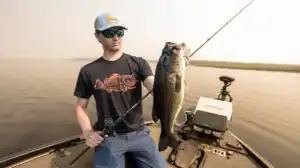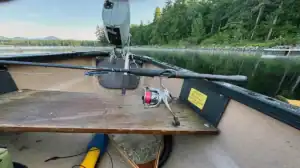We work tirelessly to offer a broad library of content here at Wired2fish. There are a lot of 101-style pieces. These entry level articles and videos are intended to help anglers grasp the fundamentals of fishing. Then there are the more advanced pieces; content that is meant to help anglers develop their skill sets further and advance their capabilities on the water.
This is one of those more advanced pieces; a master class on casting. There are several ways to manipulate the trajectory of a bait once it departs your rod tip. We’re going to briefly discuss a few of those today. Some are more well known, like skipping. Then others are a little more nuanced, like the importance of how you hold your rod when drop shotting versus punching.
DROP SHOT WITH YOUR ROD POINTED DOWN
Whether flipping, casting, skipping or dropping a bait, you always want to minimize friction on your line as much as possible. Even as smooth as modern eyelets are in rod guides, these surfaces still create resistance as the line passes through them, which has an effect on how freely the line is able to leave your reel.
This is why you’ll see expert drop shot anglers point their spinning rods straight down when dropping a bait. I first saw Elite Series pro and two-time Angler of the Year Brandon Palaniuk do this. He would point his rod straight at the water, with the butt of the rod up in the air as he dropped his bait to a bass beneath the boat.
This looked odd to me, so I asked him about it and he pointed out that doing so allowed the line to pass through the eyes freely, without having to drag over each one the way it would if he dropped his bait with his rod oriented horizontally.
By doing this, Palaniuk is able to shave several seconds off the time it takes for his bait to drop down 20 plus feet. This means the bait has a better chance of reaching the fish before it could either swim off or his boat could drift by. These are the tiny details that result in several more fish catches throughout a day and thousands more across a lifetime.
PUNCH WITH YOUR ROD POINTED UP
Interestingly enough, the opposite orientation of a punching rod will help you be more efficient around dense cover. When fishing thick mats of vegetation, punching is really the only way to get a bait to the bass that lie beneath. The thicker the vegetation, the heavier the weight that is needed to break through. Or, at least, that is the common train of thought.
However, expert punchers know that you’ll often get more bites on lighter weights. So, upping your selection from an ounce weight to a 2-ounce may make it easier to get your bait through the mat, but doing so creates a less realistic presentation to the bass and will cut down on the bites you get on the days when the bass are a little more finicky.
The better solution is to increase your efficiency with the lightest weight possible. This can be done by changing how you hold your rod on the pitch. With a drop shot rod, the focus was cutting down on the resistance on the line by minimizing the friction from the eyes. With punching, you have a much heavier weight and thus don’t need to worry about the friction of the eyes on the line as much, but instead need to make sure the line doesn’t drag or catch on the mat.
To do this, you’ll want to pitch your bait out and aim to have your rod tip pointed high in the air as the weight and bait make contact with the mat. The desired result is the bait breaking through the mat on contact and then falling clean and fast. You’ll need to drop your rod tip at the perfect rate to not hinder the fall but also not allow slack in the line—slack may cause the line to catch on the mat or prevent you from feeling the bite.
In doing all this, your bait is allowed to pass through the mat as cleanly as possible with the lightest weight possible. I believe I first heard either Randall Tharp or JT Kenny explain the importance of this; both are expert flippers who have won hundreds of thousands of dollars punching, if not more than a million between them on the technique.
SKIPPING
The positioning of your rod when skipping a bait is extremely important as well. It all comes back to minimizing resistance. Skipping a bait is a lot like skipping a rock. If you ever walked up to any body of water, picked up a stone and then tried to skip it, you know firsthand that you don’t skip the bait by throwing it overhead like you’re shooting a basketball. No, you bend down to one side and sidearm the rock, releasing it low and near the surface of the water.
You want to do the same when skipping a bait. Your rod tip needs to be low, the result of a sidearm cast or an underhanded cast. Releasing the bait low like this starts it on a trajectory parallel to the surface of the water, allowing it to skip along.
As the bait goes out, you’ll want to move your rod up and end up pointing it towards the intended target. This will minimize the friction of the rod guides on the line, allowing the line to flow freely from the spool as the bait continues to skip and ultimately come to a stop below the obstruction.
BEND A CAST
You can also bend a cast to change the trajectory of a bait. This is a lesser known skill than skipping, and one that will certainly take some time to master too. As you practice this, you’ll find that you can actually cast a bait around cover.
If you make a normal sidearm cast out into the open, you’ll notice that your bait doesn’t continue on a straight trajectory all the way until it hits the water. The bait naturally starts to curl to one side as the spool slows down. You can exaggerate this bend in the cast by slowing the spool down sooner.
For example, if you make a sidearm cast from the right-hand side, you’ll notice the bait drifts left as it nears the end of the cast, putting a curve into your line. Try making a cast like this to test this out, allowing the brakes on your reel to stop the bait. Then, make another cast with the same force, but slow your spool down down a little sooner by applying pressure with your thumb. You’ll notice the bait sails further to the left before coming down. By doing this, you can cast around objects.
Dock fishing is a good time to employ this technique. If you want to bring your bait right down the face of a dock for example, make a sidearm cast that would send the bait far beyond the dock and a little out in front of it, if the cast were unencumbered. Instead, slow the spool with your thumb about midway through the cast. The bait will curl around the dock and the bow of the line will fall onto the water out in front of the dock. Then you can fish the bait really close to the cover.
This cast is much easier to make without risking throwing over the dock, the way you might by trying to make an absolutely perfect overhand cast straight down the face of the dock. Since the bait actually goes around the dock a little with this method, you can even work the lure under the dock in some situations. Even if you could consistently make that perfect overhand cast, it’s not as good as bending the cast.
IN CONCLUSION
Remember that friction is the enemy in most situations when casting. When trying to bend a cast, you are actually adding friction with your thumb to slow the spool down a little earlier. Most of the time, thinking through the best ways to minimize friction and resistance is the best way to make your casts better.
You can do this by pointing a dropshot rod down, by pointing a punching rod up and by pointing a skipping rod ultimately at wherever you’re wanting your bait to go. There are still dozens of other ways to modify your casts and retrieves. Perhaps we’ll break those down further in the future. For now, hopefully these tips help you catch more fish the next time you hit the water.















